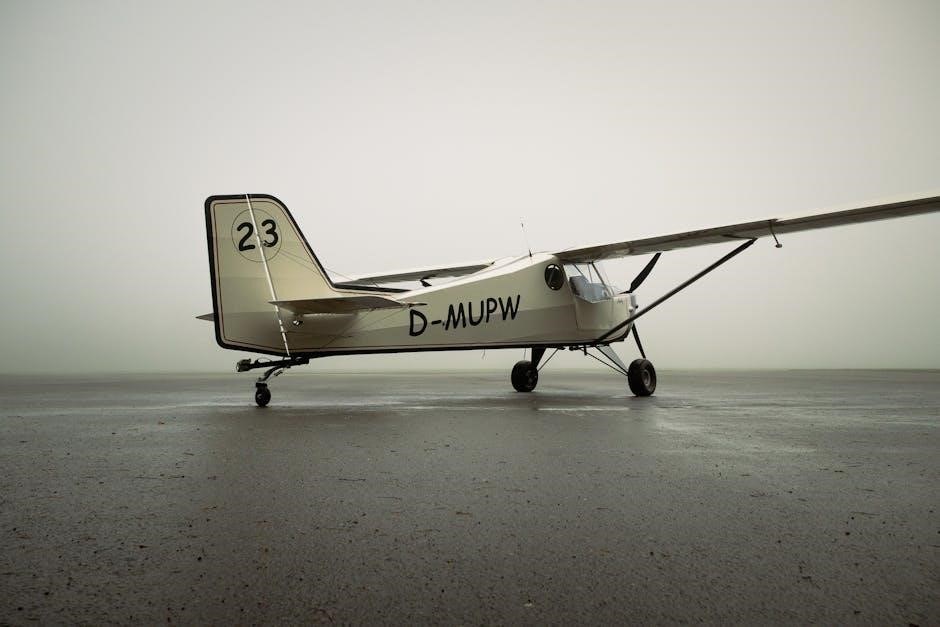oral exam guide private pilot pdf
Private Pilot Oral Exam Guide (PDF): A Comprehensive Overview
This guide offers a structured approach to ace your private pilot oral exam. It is designed to help you understand key concepts, regulations, and procedures. Accessing a PDF version allows for convenient study anytime, anywhere, ensuring thorough preparation.
The private pilot oral exam is a crucial component of the certification process, designed to assess your knowledge and understanding of aviation principles, regulations, and safe operating procedures. It’s not just about reciting facts, but demonstrating your ability to apply them in real-world scenarios. Expect questions covering a wide range of topics, from aircraft systems and aerodynamics to weather theory and flight planning. This segment of the practical test ensures you possess the cognitive skills necessary to make sound judgments as a pilot. Preparation is key; utilize resources like ASA and Jeppesen guides, alongside online practice exams, to familiarize yourself with potential questions and refine your responses. Remember, the oral exam is an opportunity to showcase your knowledge and readiness to safely operate an aircraft.
FAA Airman Certification Standards (ACS)

The FAA Airman Certification Standards (ACS) document serves as the definitive guide for the knowledge, risk management, and skill elements required for pilot certification. Specifically, the Private Pilot Airplane ACS (FAA-S-ACS-6) outlines the areas in which a pilot must demonstrate competence to earn their certificate. This document is crucial in preparing for the oral exam, as examiners will use it as a framework for their questioning. Understanding the ACS ensures you focus your study efforts on the most relevant and critical information. Familiarize yourself with each Area of Operation and Task within the ACS, and be prepared to discuss the associated knowledge elements. Mastering the ACS is the foundation for a successful oral exam and a safe flying career, enabling pilots to meet and exceed expectations.
Purpose of the Oral Exam Guide
The primary purpose of this Private Pilot Oral Exam Guide is to thoroughly prepare student pilots for the oral portion of their practical exam with FAA examiners. Designed in a user-friendly question-and-answer format, this guide presents the most frequently asked questions, along with concise and readily understandable responses. This comprehensive resource is invaluable both for students gearing up for their checkride and for certified pilots seeking a general knowledge refresher. It aims to evaluate a pilot’s understanding of the knowledge areas specified in the FAA Airman Certification Standards (ACS). By mastering the material within this guide, pilots can confidently demonstrate their knowledge and ensure a successful oral exam experience, promoting aviation safety and proficiency.
Key Knowledge Areas Covered
This Private Pilot Oral Exam Guide comprehensively covers the essential knowledge areas mandated by the FAA for private pilot certification. These areas encompass a wide range of topics, including aircraft systems, aerodynamics, weather, regulations, navigation, flight planning, performance charts, airspace, and aviation physiology. The guide provides detailed explanations and examples to ensure a thorough understanding of each subject. Furthermore, it addresses scenarios and decision-making processes relevant to real-world flying situations. By mastering these key knowledge areas, student pilots will be well-prepared to answer any questions posed by FAA examiners during the oral exam. This ensures that applicants demonstrate adequate aeronautical knowledge, contributing to safer and more informed pilots. The guide is structured to align with the ACS, promoting effective learning and exam preparation.

Required Documents and Regulations
Understanding the necessary documents and regulations is crucial for private pilots. This section details pilot and medical certificate requirements, currency regulations, and relevant FAR/AIM sections. Compliance ensures legal and safe flight operations.
Pilot Certificate Requirements
To act as pilot in command (PIC), you must hold a valid pilot certificate. This certificate verifies that you have met the FAA’s knowledge and skill requirements. Be prepared to present your pilot certificate during ramp checks or inspections. Ensure your certificate is not expired, suspended, or revoked. Remember that your pilot certificate reflects your qualifications to operate specific aircraft. Check that your certificate aligns with the aircraft category and class you intend to fly. The certificate also indicates any limitations or endorsements you may have. It is essential to understand the privileges and limitations associated with your specific pilot certificate. Always keep your pilot certificate readily accessible during flight operations. Maintaining your pilot certificate is a key responsibility as a private pilot. Familiarize yourself with the regulations governing pilot certification.
Medical Certificate Requirements
A valid medical certificate is crucial for exercising the privileges of a private pilot certificate. This certificate ensures you meet the FAA’s minimum health standards. There are three classes of medical certificates: first, second, and third. The class required depends on the type of flying you intend to do. A third-class medical certificate is typically sufficient for private pilots. Ensure your medical certificate is current and not expired, as flying with an expired medical is a violation. Keep your medical certificate readily available during all flight operations. Be aware of the duration of each medical certificate class. Certain medical conditions may disqualify you from obtaining a medical certificate. Report any changes in your medical condition to your Aviation Medical Examiner (AME). You may need to undergo a medical examination to renew your certificate. Adhering to medical certificate requirements is essential for safe flying.
Currency Requirements
Maintaining currency as a private pilot is paramount for safe and legal flight operations. Currency ensures that you have the recent experience necessary to operate an aircraft safely. The FAA establishes specific requirements that pilots must meet to remain current. These requirements typically involve completing a flight review every 24 calendar months. A flight review consists of a minimum of one hour of ground instruction and one hour of flight training. To carry passengers, you must have completed three takeoffs and landings within the preceding 90 days in an aircraft of the same category, class, and type. For night flights with passengers, these takeoffs and landings must have been performed at night. Instrument-rated pilots have separate currency requirements for instrument flying. Staying current involves regular flight practice and review of aviation regulations. It is the pilot’s responsibility to ensure they meet all currency requirements before each flight. Failing to meet currency requirements can lead to legal penalties and safety risks. Always prioritize safety and adhere to FAA regulations.
Relevant FAR/AIM Sections
Understanding relevant Federal Aviation Regulations (FARs) and the Aeronautical Information Manual (AIM) is crucial for private pilots. These resources provide the rules, regulations, and procedures that govern aviation in the United States. Key FAR sections for private pilots include Part 61, which outlines pilot certification requirements, and Part 91, which covers general operating and flight rules. The AIM offers guidance on various aspects of flight operations, including airport operations, air traffic control procedures, and weather information. Pilots should be familiar with sections pertaining to preflight actions, flight planning, and emergency procedures. Specific regulations regarding medical certificates, aircraft maintenance, and equipment requirements are also important. Staying updated on changes to the FAR/AIM is essential for safe and legal flying. Pilots can access these resources online or through printed publications. Regular review of relevant sections will enhance pilots’ knowledge and decision-making abilities. Referencing these documents during flight planning and operations ensures compliance and promotes safety. Utilizing the FAR/AIM effectively is a hallmark of a professional and responsible pilot.

Privileges and Limitations of a Private Pilot

Private pilots enjoy the privilege of flying for personal or recreational purposes. However, they face limitations, such as restrictions on flying for compensation or hire, ensuring aviation safety.
Acting as Pilot in Command (PIC)
As Pilot in Command (PIC), a private pilot assumes ultimate responsibility for the flight’s safety and operation. This includes ensuring the aircraft is airworthy, all required documents are onboard, and the flight complies with regulations. The PIC makes critical decisions regarding weather, route, and aircraft performance. Before each flight, a thorough pre-flight inspection is essential to identify any potential issues. The PIC must also be proficient in aircraft systems, emergency procedures, and navigation techniques. Maintaining situational awareness throughout the flight is paramount. Moreover, understanding and adhering to all applicable Federal Aviation Regulations (FARs) is crucial for legal and safe operations. The PIC’s judgment and decision-making abilities are vital for a successful and safe flight. Ultimately, the PIC is accountable for the well-being of passengers and the safe completion of the flight.
Carrying Passengers
A private pilot can carry passengers, but specific regulations and responsibilities apply. The pilot must ensure that passengers are briefed on safety procedures, including seatbelt usage and emergency exits. It is the pilot’s responsibility to verify that the aircraft is suitable for the number of passengers and weight being carried. Before the flight, the pilot should assess passenger fitness for flight, considering any potential health issues. Passengers should also be made aware of the planned route and potential weather conditions. Importantly, a private pilot cannot carry passengers for compensation or hire, with limited exceptions outlined in the FARs. Maintaining passenger comfort and safety is a key aspect of responsible pilotage. Furthermore, the pilot must be current in all required flight experience, including recent takeoffs and landings, to legally carry passengers. Understanding these regulations is critical for safe and compliant flight operations.
Prohibited Operations
Private pilots face limitations on the types of operations they can conduct. They are prohibited from flying for compensation or hire, meaning they cannot receive payment for their services as a pilot, directly or indirectly. Exceptions exist for certain operations, such as sharing operating expenses with passengers. Furthermore, private pilots cannot act as pilot in command (PIC) in furtherance of a business unless the flight is incidental to that business and no passengers are carried. Operations requiring commercial certification, like air ambulance services or banner towing, are also prohibited. Flying contrary to regulations, such as exceeding aircraft limitations or operating without proper maintenance, is strictly forbidden. It’s crucial to adhere to FAA regulations, ensuring safety and avoiding legal repercussions. Understanding these prohibitions guarantees compliance and prevents inadvertent violations. Also, private pilots can’t act as PIC of an aircraft carrying persons or property for compensation or hire.

Resources for Oral Exam Preparation

Effective oral exam preparation involves utilizing various resources. These include study guides, practice exams, and online materials. These materials will help solidify your knowledge and boost confidence. Good luck preparing for your exam!

ASA Private Pilot Oral Exam Guide
The ASA Private Pilot Oral Exam Guide is a popular resource for students preparing for their checkride. It presents questions and answers in an organized format, covering the knowledge areas outlined in the FAA Airman Certification Standards (ACS). This guide contains the questions most likely to be asked by examiners and provides succinct, ready responses.
This guide is designed to help student pilots for the oral exam portion of their checkride with FAA examiners. It compiles frequently asked questions with clear, concise answers to aid in quick learning and retention. ASA, Aviation Supplies & Academics, Inc., offers this guide to pilots.
Utilize this resource when gearing up for the Practical Exam, as well as for a general refresher. It is a comprehensive tool to ensure you’re well-prepared.
Jeppesen Private Pilot Test Guide
The Jeppesen Private Pilot Test Guide is another valuable resource for aspiring pilots preparing for their oral exam. This guide, often used in conjunction with Jeppesen’s flight training curriculum, provides comprehensive coverage of essential topics. It’s specifically designed to help you get the most out of your product by providing a manual.
It assists pilots in understanding the theoretical knowledge required for safe and efficient flight operations. The guide includes detailed explanations, diagrams, and practice questions to reinforce learning. Also, it is a manual that helps to get the most out of your product.
The Jeppesen guide is structured to align with the FAA’s practical test standards, ensuring candidates are well-prepared for their checkride. It serves as a reliable tool for mastering the knowledge necessary to become a competent and confident private pilot.

Online Practice Exams

Online practice exams are a crucial component of effective oral exam preparation for the private pilot certificate. These exams simulate the actual testing environment, allowing candidates to familiarize themselves with the question format and content.
Several websites and apps offer practice exams covering various topics outlined in the FAA Airman Certification Standards (ACS). These resources often provide immediate feedback, highlighting areas where further study is needed. Mimicking the real FAA Private Pilot Written Exam, these exams can ease anxiety for the oral portion of the checkride.
By consistently utilizing online practice exams, aspiring pilots can reinforce their knowledge, identify weaknesses, and build confidence. This proactive approach significantly increases the likelihood of success on the oral exam, demonstrating a thorough understanding of aviation principles and regulations.
